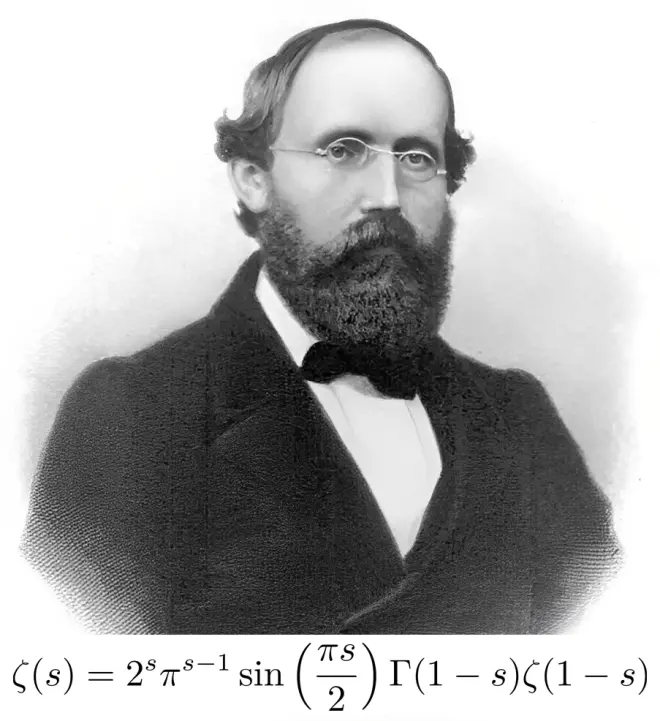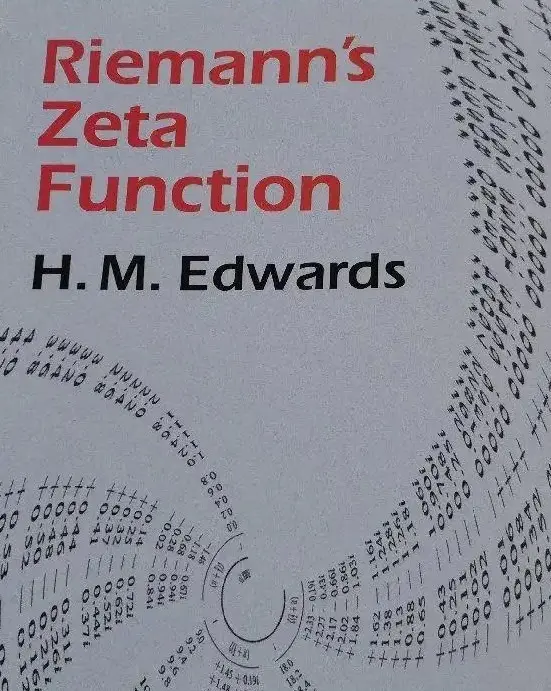翻译Riemann's zeta function(H.M.Edwards) 黎曼Zeta函数,黎曼猜想


H.M.Edwards所著的Riemann's zeta function是关于黎曼猜想一本经典参考书,本人打算逐步将此书翻译出来。喜欢的读者一定要多多点赞、收藏、转发、关注。若发现有任何错误,欢迎通过评论或私信向我指出。
以下是前言的译文。

在这本书中,我的主要目标是提出一个观点,这个观点不是关于解析数论,而是关于数学是以并且应当是以何种方式进行学习。简而言之,我已经尝试告诉数学专业的学生,他们应该阅读经典原作,同时要当心那些二手资料。
这个观点是埃里克·坦普尔·贝尔(Eric Temple Bell)在他写的关于伟大数学家的传记——《数学大师》一书中反复提及的。通过一个又一个的案例,贝尔指出,他在书中所写的数学家,并非通过在学校或者读教科书来学习数学,而是通过直接看一手资料,以及阅读前辈大师们最杰出的工作来学习。这一观点在大多数学术领域以及多数历史时期都是不言而喻的。
没有一项数学工作比黎曼发表于1859年的论文——《论小于某给定值的素数的个数》更加经典。自黎曼之后,许多伟大的数学家(在此仅列举少数最重要的),如哈达玛(Hadamard)、冯·曼戈尔特(von Mangoldt)、德·拉·瓦利·普桑(de la Vallee Poussin)、兰道(Landau)、哈代(Hardy)、李特尔伍德(Littlewood)、西格尔(Siegel)、波利亚(Polya)、詹森(Jensen)、林德洛夫(Lindelof)、玻尔(Bohr)、塞尔伯格(Selberg)、阿廷(Artin)、赫克(Hecke),他们的大量工作均是直接源于黎曼的八页论文中所包含的思想。据传说,在赫维茨(Hurwitz)去世后,从阿道夫·赫维茨图书馆获得黎曼论文集的人发现,论文集会自动打开到阐述黎曼猜想的那一页。
然而,可以肯定地说,不仅当代数学家很少听到“读经典原文”这句格言,如今也很少有学生读过《论小于……》。相反地,前几代的数学通常被认为是不严谨和幼稚的,用模糊的术语表述,而这些术语可以被现代术语大大简化,同时还充满了错误的基础和陈述——这些都是建议学生尽量避免的。黎曼则尤其应该回避,因为其缺乏严谨性的名声(他的“狄利克雷(Dirichlet)原理”为人所铭记,更多的是因为魏尔斯特拉斯(Weierstrass)指出了其证明的不足之处,而不是因为它终究是正确的,以及黎曼借此让阿贝尔函数的研究有了革命性的进步),因为他难懂的风格,也因为人们普遍认为他的作品中有价值的部分都已被收集和整合到后来更严格、更具可读性的作品中了。
这些反对意见都是有效的。当黎曼做出断言时,它可能是读者可以自己验证的东西,可能是黎曼已经证明或打算证明的东西,可能是多年后才被严格证明的东西,也可能是迄今都尚未证明的东西,同时还可能是不正确的东西,除非假设得到加强。这对于现代读者而言是尤其痛苦的,因为他们受到的训练是:在阅读下一句话之前,必须先消化之前的每一句话。此外,黎曼的写作风格极其难懂。他悲惨而又短暂的一生被数学创造力占得太满,以至于他没有太多精力对所有的成果进行优雅地阐述或完美地呈现。他的作品极其简明扼要,尤其是《论小于某给定值的素数的个数》,只是他没有时间用更长的篇幅进行阐述的大量研究的一个摘要。此论文是黎曼公开发表的关于数论的唯一论文,尽管西格尔在黎曼未发表的手稿中找到了很多关于数论的有价值的新材料。最后,毫无疑问,黎曼大部分的精彩思想都被收进了后续更具可读性的作品中。
尽管如此,在这种情况下,人们还是应该像在其它情况下一样阅读经典著作。没有任何二手资料可以复制黎曼的见解。黎曼遥遥领先于他的时代,直到论文发表30年后,其他人才真正开始领会他的思想——更不用说自己能产生价值相当的想法了。事实上,黎曼领先于他的时代如此之远,以至于西格尔从黎曼未发表的手稿整理而来并于1932年发表的成果,成了西格尔在这一领域的主要贡献,而此事是在黎曼发现这些结果70多年以后。任何对黎曼思想的简化、意译或改写,都有丢失重要思想、掩盖黎曼见解来源的要点、引入新的技术细节或无需过多关注的次要问题的重大风险。自黎曼之后,我不相信任何数学家有能力修订他的作品。
敏锐的读者肯定会注意到这里的矛盾:一本二手资料在指责二手资料。我似乎在说:“不要读这本书。” 但他也将看到这个矛盾的答案。我想说的是:阅读经典原著,不仅仅是黎曼的作品,还有我在本书中讨论的所有对解析数论有重大贡献的作品。二手资料的目的是告诉你有哪些一手资料,如果你能阅读和理解一手资料而不阅读本书,你将拥有更强的能力。如果你只阅读本书而不阅读一手资料,那你就像一个带着午餐去参加宴席的人。

英文原文如下:
My primary objective in this book is to make a point, not about analytic number theory, but about the way in which mathematics is and ought to be studied. Briefly put, I have tried to say to students of mathematics that they should read the classics and beware of secondary sources.
This is a point which Eric Temple Bell makes repeatedly in his biographies of great mathematicians in Men of Mathematics. In case after case, Bell points out that the men of whom he writes learned their mathematics not by studying in school or by reading textbooks, but by going straight to the sources and reading the best works of the masters who preceded them. It is a point which in most fields of scholarship at most times in history would have gone without saying.
No mathematical work is more clearly a classic than Riemann's memoir Ueber die Anzahl der Primzahlen unter einer gegebenen Grosse, published in 1859. Much of the work of many of the great mathematicians since Riemann like Hadamard,von Mangoldt, von de la Vallee Poussin, Landau, Hardy, Littlewood, Siegel, Polya, Jensen, Lindelof, Bohr, Selberg, Artin, Hecke, to name men just a few of the most important has stemmed directly from the ideas contained in this eightpage paper. According to legend, the person who acquired the copy of Riemann's collected works from the library of Adolph Hurwitz after Hurwitz's death found that the book would automatically fall open to the page on which the Riemann hypothesis was stated.
Yet it is safe to say both that the dictum "read the classics" is not much heard among contemporary mathematicians and that few students read Ueber die Anzahl... today. On the contrary,. the mathematics of previous generations is generally considered to be unrigorous and naive, stated in obscure terms which can be vastly simplified by modern terminolny, and full of false starts and misstatements which a student would be best advised to avoid. Riemann in particular is avoided because of his reputation for lack of rigor (his "Dirichlet principle" is remembered more for the fact that Weierstrass pointed out that its proof was inadequate than it is for the fact that it was after all correct and that with it Riemann revolutionized the study of Abelian functions), because of his difficult style, and because of a general impression that the valuable parts of his work have all been gleaned and incorporated into subsequent more rigorous and more readable works.
These objections are all valid. When Riemann makes an assertion, it may be something which the reader can verify himself, it may be something which Riemann has proved or intends to prove, it may be something which was not proved rigorously until years later, it may be something which is still unproved, and, alas, it may be something which is not true unless the hypotheses strengthened. This is especially distressing for a modern reader who is trained to digest each statement before going on to the next. Moreover, Riemann's style is extremely difficult. His tragically brief life was too occupied with mathematical creativity for him to devote himself to elegant exposition or to the polished presentation of all of his results. His writing is extremely condensed and Ueber die anzahl... in particular is simply a resume of very extensive researches which he never found the time to expound upon at greater length; it is the only work he ever published on number theory, although Siegel found much valuable new material on number theory in Riemann's private papers. Finally, it is certainly true that most of Riemann's best ideas have been incorporated in later, more readable works.
Nonetheless, it is just as true that one should read the classics in this case as in any other. No secondary source can duplicate Riemann's insight. Riemann was so far ahead of his time that it was 30 years before anyone else began really to grasp his ideas——much less to have their own ideas of comparable value. In fact, Riemann was so far ahead of his time that the results which Siegel found in the private papers were a major contribution to the field when they were published in 1932, seventy years after Riemann discovered them. Any simplification, paraphrasing, or reworking of Riemann's ideas runs a grave risk of missing an important idea, of obscuring a point of view which was a source of Riemann's insight, or of introducing new technicalities or side issues which are not of real concern. There is no mathematician since Riemann whom I would trust to revise his work.
The perceptive reader will of course have noted the paradox here of a secondary source denouncing secondary sources. I might seem to be saying, "Do not read this book." But he will also have seen the answer to the paradox. What I am saying is: Read the classics, not just Riemann, but all the major contributions to analytic number theory that I discuss in this book. The purpose of a secondary source is to make the primary sources accessible to you. If you can read and understand the primary sources without reading this book, more power to you. If you read this book without reading the primary sources you are like a man who carries a sack lunch to a banquet.

